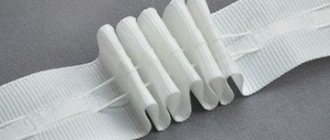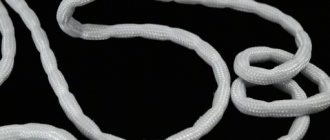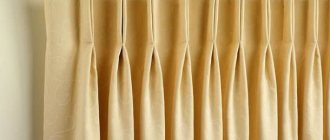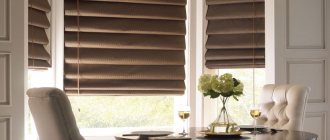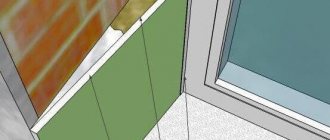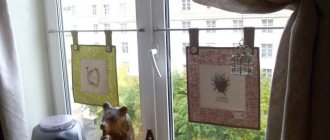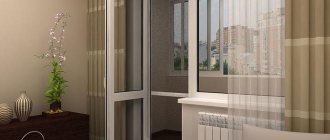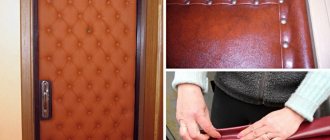This article describes how to sew curtain tape to tulle, curtains, and drapes.
To make a new interior in a room, it is not necessary to make expensive repairs or change furniture. It will be enough to buy new curtains or tulle and decorate the window in the room with them. Such decoration using new textiles will add new accents to the interior and make it stylish and beautiful.
Many women buy new tulle and prefer to design the textiles themselves, as well as sew on the ribbon. In this article we will tell you how to choose the right ribbon for tulle and how to sew a wide or narrow ribbon. Read the tips, watch the video and you will be able to drape the window beautifully yourself.
Which curtain tape is best for tulle: how to choose?
Which curtain tape is best for tulle: how to choose?
Curtain tape is a braid with special twisted cords sewn along its entire length. It is an excellent foundation for creating any folds. If you want to make beautiful folds on the tulle, you do not need to acquire special fashion designer skills; sew on curtain tape and beautiful window drapery will be ensured.
Which curtain tape is best for tulle: types of tape
Which curtain tape is best for tulle and how to choose it? Adviсe:
- First, decide on the type of folds you want to see on your tulle : waffle folds, pencil folds, bow folds, Flemish folds. But, if these names don’t mean anything to you, then just take several types of ribbons and assemble them. You will immediately see what kind of fold pattern you will get in the end.
- Remember that the folds on tulle will not be particularly visible, since the fabric is weightless and airy. But the general relief will still be visible.
- If you have made unusual and beautiful folds on the curtains, then you don’t have to bother with the tulle and choose a tape of uniform gathering.
- For tulle, use clear fishing line tape. The same tape is used for thin curtains.
- The type of curtain tape determines the amount of tulle. For convenience, the ratio used is 1:3, 1:2, 1:2.5 and 1:1.5. These figures indicate that for 1 meter of window opening you will need, for example, 3 meters of tulle plus another 10 centimeters.
To make a plain tulle look beautiful on a window, you should use a coefficient of 2.5 or 3, since with a coefficient of 1.5 the tulle will be barely gathered.
What you will need
Prepare the material. The braid is selected taking into account the properties of the fabric (its density). There are special types of products for transparent fabrics. Thick curtains should be hemmed with a white stripe. The corsage option is used to increase the rigidity of the trouser waistband.
It is a product of medium width without fastening elements. Theoretically, you can attach it to curtains, but to fix it to the curtain rod you need to make loops. This option is being considered to hang very thick curtains.
Determine the amount of material. To do this, measure the length of the cornice and multiply the resulting value by the assembly factor. Also add 5-6 cm to the folds.
Other materials, tools:
- scissors;
- thread with a needle for basting;
- pencil or chalk.
How much curtain tape is needed for tulle?
How much curtain tape is needed for tulle?
The meter of the tape is calculated depending on how much tulle you need to drape. So, how much curtain tape do you need for tulle? Use the coefficients described above. The second number in the coefficient indicates how many meters of fabric will be needed to cover 1 meter of opening. For example, to buy a tape with a ratio of 1:3 for a window with a width of 2.5 meters, you will need 7.5 meters of tulle and the same amount of braid.
If you have already purchased curtains, then select a braid with a suitable coefficient. To do this, divide the width of the fabric by the width of the opening. For example, a curtain is 4 meters, and a window opening is 2 meters, then you need to divide 4 by 2. The result is a ratio of 2 or 1:2.
Material preparation process
Before you sew the braid onto the curtain, you need to prepare it. For this:
- The curtain is being ironed. There should be no folds left on it. The fabric is ironed in accordance with the rules for caring for the material from which it is made.
- If the edges of the product are not processed, then they are hemmed, bending them twice.
- The loops on the tape are checked using an awl, screwdriver or any thin object. This is done so as not to sew the braid on the wrong side.
How to properly assemble tulle on a curtain tape: rules, tips, photos
How to properly assemble tulle on a curtain tape: rules, tips, photos
Draping the fabric is the most crucial moment, so it is important to pull the tulle or curtain correctly. How to properly assemble tulle on a curtain tape - rules and tips:
- It’s better to pull together together , so ask someone to help. If there are several cords, then they need to be pulled together on both sides.
- When tightening, the cord will get in the way , since it is very long, so tie a piece of cardboard and wind the cord around such a bobbin. You can also buy a special retainer in the store that is used for these cases.
- While tightening, measure the curtain or tulle to achieve the desired width. It is better to do this with a soft measuring tape.
- When you have the desired width of the curtain , fix the edges and straighten the folds. Hang curtains or tulle on hooks.
How to properly assemble tulle on a curtain tape: rules
Important: For the curtain to look beautiful, the distance between the hooks must be at least 10 cm.
How to properly assemble tulle on a curtain tape: rules, tips
Self-drapery of curtains and tulle will help you decorate the room yourself, without resorting to the services of specialists. Give your interior an elegant and finished look, saving on the services of a fashion designer, especially since this is easy to do with different types of curtain tape.
Common mistakes made by newbies
In some cases, novice craftsmen may have problems. Lack of experience often leads to avoidable mistakes. The instructions below will help you get the firmware installed correctly the first time.
How to choose the right door to your apartment?- Kitchen design in Khrushchev: useful tips for those who have a small kitchen (100+ photos)
Which laminate to choose?
- After washing, the material may shrink and, in principle, cannot be used further. This can only be corrected later by cutting and re-stitching. However, this is easy to avoid - you just need to leave extra supply of tape.
- Often, laces fall out of place, causing irreparable damage. The best way is to tie strong knots on the sides that will prevent it from moving freely. The best solution would be to make pockets on the reverse side. The ropes are placed in them, after which they are fixed and will no longer be able to fall out.
- In the middle of the tape there is a tightening seam, which is easily damaged during operation. If you cut it, subsidence will occur. It will not give the proper tension.
Tips from experienced seamstresses
Experienced seamstresses share small tricks for sewing high-quality and beautiful curtains:
- Choose your threads carefully. For thick curtains, choose colored threads to match; for braids, choose white threads of the same thickness. Thread two colors of thread into the machine.
- Adjust the sewing machine properly to the type of material. Set the appropriate thread tension, foot pressure and stitch size in 3-4mm increments.
- Check the machine needle. Strengthen a thin, even, sharp needle. Test it on a small piece of thin fabric. If there are no puffs, then you can sew.
- Choose the right textile tape. It is necessary that it be invisible and not seem like something foreign on the curtain.
- Pre-wash the braid and fabric in warm water without detergent to prevent shrinkage in the future.
- Wrap the long ends of the cords on a piece of paper and place them in the unsewn edge of the tape or in special pockets mounted on the curtain. This way the cords will not get tangled.
- Before you start sewing curtains from expensive material, try sewing a kitchen or garden curtain from plain cotton. Practice sewing techniques and try different types of draperies. Start with simple types of drapery and inexpensive materials.
- If it is not possible to sew the tape to the curtain (for example, the machine is broken), use tape with hot-melt adhesive. It just needs to be ironed.
Options for decorative folds
Braid with different “K” coefficients forms various types of draperies. The “K” value is indicated on the hardware label.
Drapery options are grouped in the table.
| Types of drapery assembly | Features, attachment, SL size, “K” coefficient value |
| "Accordion" - easy assembly | Narrow parallel pleats for thin and delicate fabrics. Transparent LH: 6 cm, K=1.5 Hook fastening to a string, thin rod. |
| “Pencil” (“columns”) – classic version | Narrow vertical folds. Wide three-row LH: 7.5 cm, K=2.5. Hook attachment. |
| "Sleeves" or "wave" | Round folds. Three-cord SL: 9-10 cm, K=2. Suitable for long curtains with detachable hooks. |
| French folds | Fan assemblies with three tucks and two pockets 14 cm deep. Double-row L: 8.5 cm, K=2. Optimal for any fabric. Recommended for long curtains. Do not overtighten the cords - the pattern will be disrupted. |
| Double pleated | Three rows of narrow folds in a checkerboard pattern. Four-cord SHL with two pockets: 10 cm, K=2 |
| Counter pleats | Double-row SL: 7.5 cm, K-2. Under detachable hooks. |
| Diamond folds. Varieties: “butterfly”, “waffles”, “checkerboard” | Formed into rhombuses. Double-row four-cord SL: 7.5 cm, K=2.5. Lay 4 lines along the cords. |
| Flemish assemblies (“glasses”) | The fold consists of 3-5 tucks that make up the bottom of the glass, transitioning into a large rounded gather (the top of the glass). Wide four-cord fittings: K=2-2.5. Fastening with detachable hooks. Suitable for long curtains. |
| Bow drapery (bow) | Flat folds laid in opposite directions form a bow. Double-row, two- or four-cord tape 5 cm, K=2.5-3. Recommended for short curtains, frills. Not suitable for sliding curtains. |
| Trellis fold | It is formed by two counter-directed tucks. Three-cord tape with three stitched rows |
| "Tulip" | The lower part of the SL is gathered, and a fold is made on top, reminiscent of a tulip. The form is reinforced with filler. |
| One-sided folds | The gathers are directed in one direction and are represented by even tucks. |
| "Chicken feet" | Three pintucks at the bottom of the HL, diverging upward. |
When buying braid, test it. Rigid, neat assembly guarantees a beautiful appearance of the product.
Peculiarities
To attach curtains to curtains or ceiling cornices, fastenings are required. Fittings are made from various materials:
- metal-plastic;
- non-ferrous metal;
- aluminum;
- become;
- light and durable polymer.
Hooks or rings usually come with curtain rods. Toothed crocodile clips are used for heavy materials, clips are used for organza and tulle.
